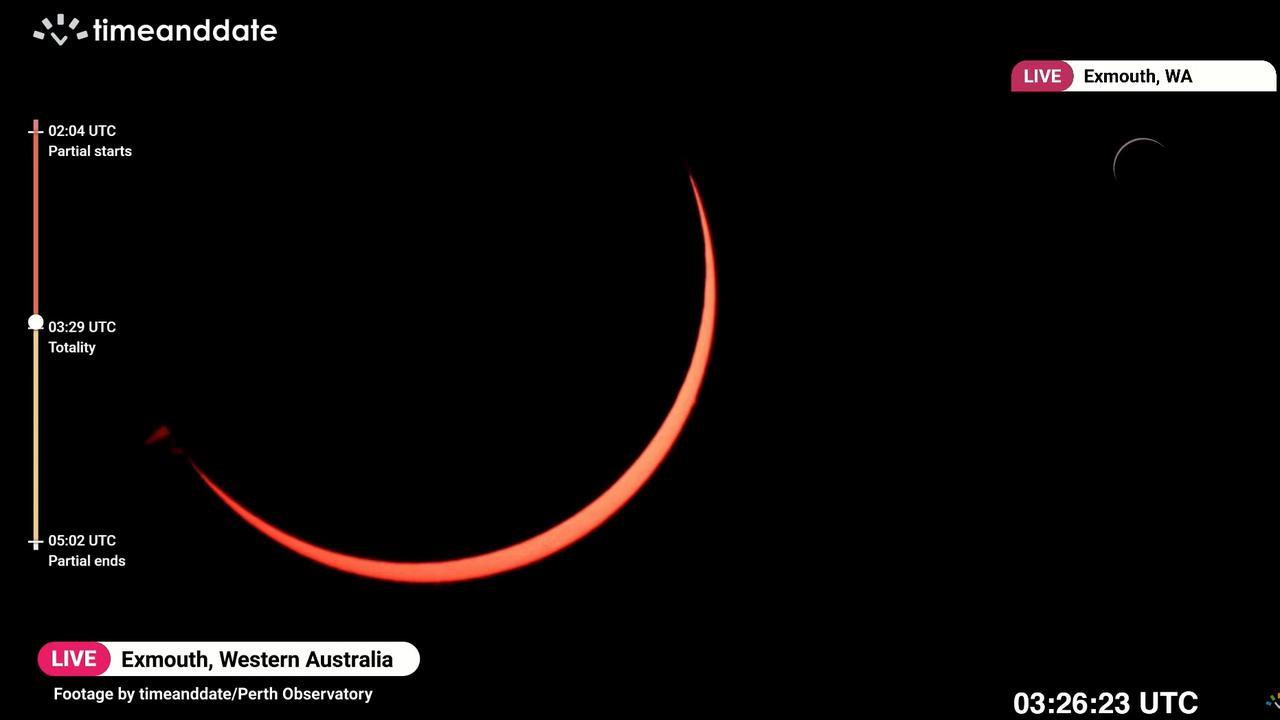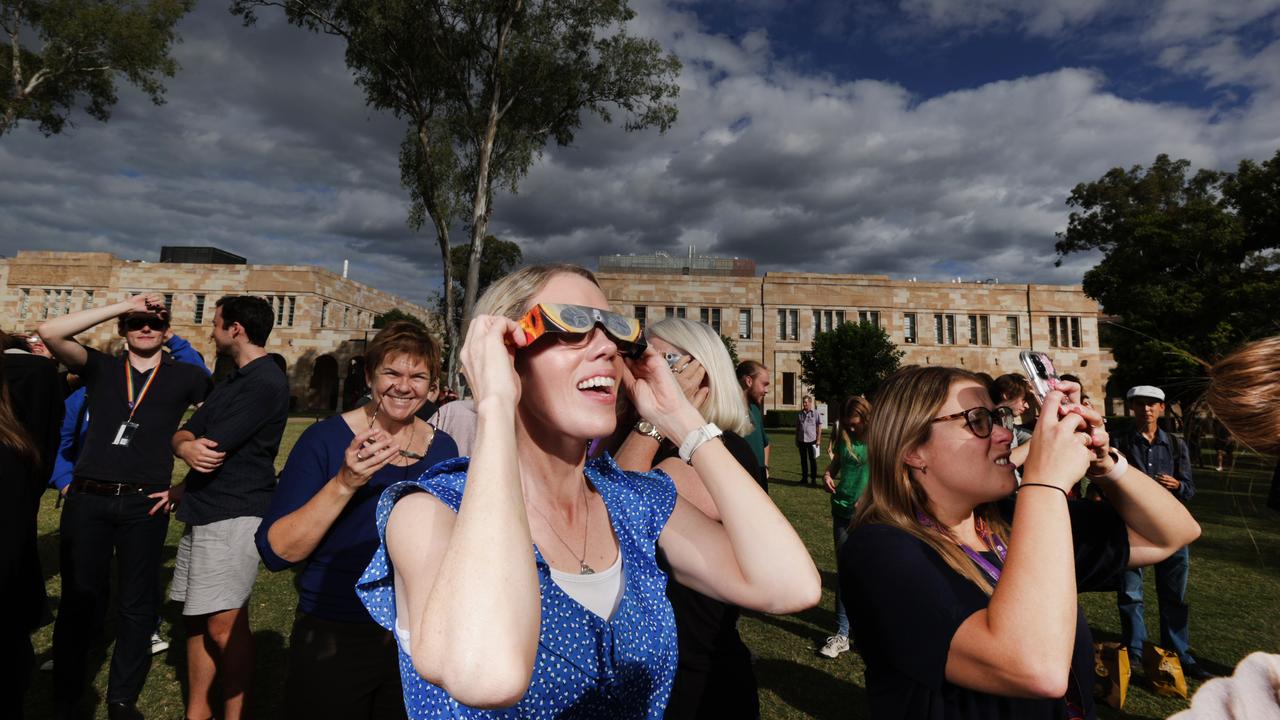Total solar eclipse turns on stunning astronomical show above Exmouth, WA
Thousands of tourists flocked to a remote town in Western Australia for a front-row seat to a spectacular and rare total solar eclipse

READING LEVEL: GREEN
A remote town in Western Australia had a front-row seat to a spectacular and rare total solar eclipse.
Thousands of tourists flooded into Exmouth, 1200km north of Perth, to watch the moon pass in front of the sun on April 20, turning the region dark for 62 seconds despite it being the middle of the day.
Exmouth and a small part of the surrounding area were the only places in Australia that were directly under the path of the moon’s central shadow, meaning 100 per cent of the sun was covered by the moon for a short time.
While the whole event lasted about three hours, the sun was only totally blocked by the moon for just over a minute.
A solar eclipse occurs when the moon passes between the sun and the Earth, casting a shadow on the Earth’s surface. During a solar eclipse, the moon appears to cover the sun partially or completely, creating a stunning visual display.
While Exmouth was the only place to see the total eclipse, it was visible as a partial eclipse in other parts of Australia.
In Darwin, 80 per cent of the sun was covered and Perth saw a 70 per cent partial eclipse. Adelaide saw 21 per cent of the sun blocked, Brisbane 16 per cent and Sydney, Melbourne and Canberra 10 per cent. Hobart saw a 5 per cent partial solar eclipse.

Associate Professor Katarina Miljkovic, from Curtin University’s Space Science and Technology Centre, said Exmouth was lucky to be treated to the full astronomical* show.
“The solar eclipse, and specifically the total eclipse, is a unique* astronomical phenomenon* that occurs about once a year but is visible only from a tiny portion on the surface of our planet,” Professor Miljkovic said.
“Given that two-thirds of our surface is covered by oceans, it is very frequent that the path of the totality falls on the oceans, where it is extremely hard to witness the event.”

Astronomical Society of Australia president John Lattanzio said total solar eclipses were so spectacular that some people followed them around the world.
“Many people become addicted to that minute or so of eerie* otherworldliness* known as totality,” he said.
“They become ‘eclipse chasers’ and they travel all over the world for repeat experiences.”

Professor Lattanzio said Australia “really is the lucky country” because we would get to see five total eclipses in various parts of the country over the next 15 years.
But he said solar eclipses would not keep happening forever, as the moon slowly moved away from Earth.
“It requires the moon to totally cover the sun. But the moon is moving away from us and so we will only have eclipses for another 600 million years,” he said.
“Best to look at them now, while you have the chance!”
Australia’s next total solar eclipse will pass over Sydney in 2028.
If you’re planning to put a viewing on your 2028 calendar, make sure you are prepared with equipment, such as approved solar eclipse glasses, that will protect your eyes. Looking directly at the sun with your naked eye can cause serious and permanent damage.
GLOSSARY
- astronomical: to do with the sky, space and universe
- unique: unlike anything else, one of a kind
- phenomenon: something that exists and can be seen, felt, tasted etc
- eerie: strange, spooky
- otherworldliness: to do with something that seems strange or spiritual, and not connected to ordinary things
EXTRA READING
Get set for a ‘Ring of Fire’ solar eclipse
Rare blood moon to appear in Australian sky
Get set for a very special lunar eclipse
The moon, its history, and impact on our lives
QUICK QUIZ
- In which remote WA town was the total eclipse visible?
- For how long did the moon completely block out the sun?
- What proportion of the sun was blocked out for people watching from Hobart?
- How many total solar eclipses will Australia see in the next 15 years?
- Why will solar eclipses no longer happen in 600 million years?
LISTEN TO THIS STORY
CLASSROOM ACTIVITIES
1. Visions of a total eclipse
Draw seven circles of the same size. Now colour in how much coverage the moon had on the sun in the recent solar eclipse in the locations below. Use the percentages from the Kids News article to colour one circle for each location:
- Exmouth, WA
- Darwin, NT
- Perth, WA
- Adelaide, SA
- Brisbane, Qld
- Sydney, NSW/Melbourne, Victoria/Canberra, ACT
- Hobart, Tasmania
Time: allow 20 minutes to complete this activity
Curriculum Links: Mathematics
2. Extension
Look at the following map and location of solar eclipses in the coming years.
Use a map to jot down the locations of these and plan where you might go on holiday to coincide with one or more of these like the ‘eclipse chasers’.

VCOP ACTIVITY
Read this!
A headline on an article – or a title on your text – should capture the attention of the audience, telling them to read this now. So choosing the perfect words for a headline or title is very important.
Create three new headlines for the events that took place in this article. Remember, what you write and how you write it will set the pace for the whole text, so make sure it matches.
Read out your headlines to a partner and discuss what the article will be about based on the headline you created. Discuss the tone and mood you set in just your few, short words. Does it do the article justice? Will it capture the audience’s attention the way you hoped? Would you want to read more?
Consider how a headline or title is similar to using short, sharp sentences throughout your text. They can be just as important as complex ones. Go through the last text you wrote and highlight any short, sharp sentences that capture the audience.

